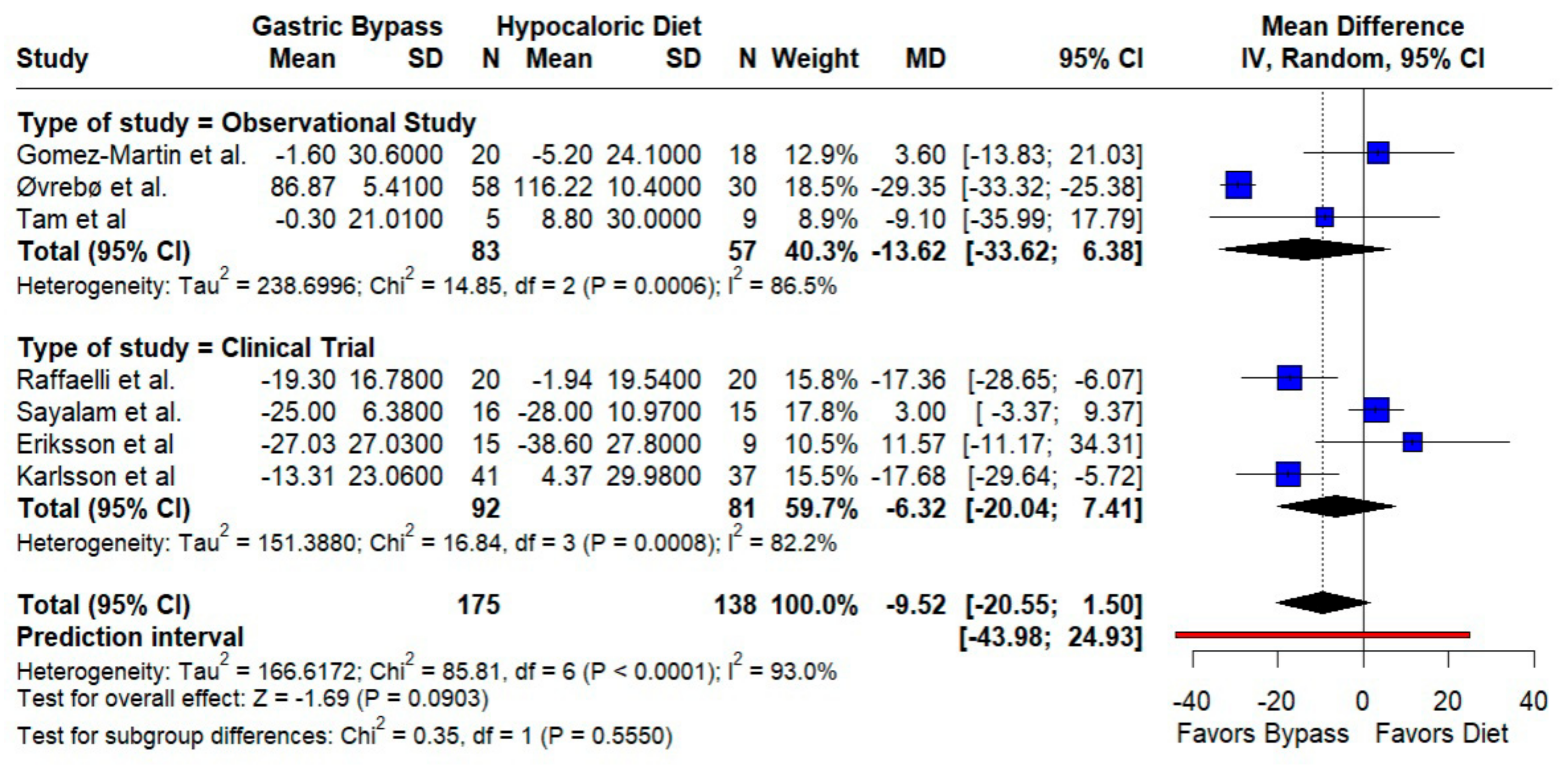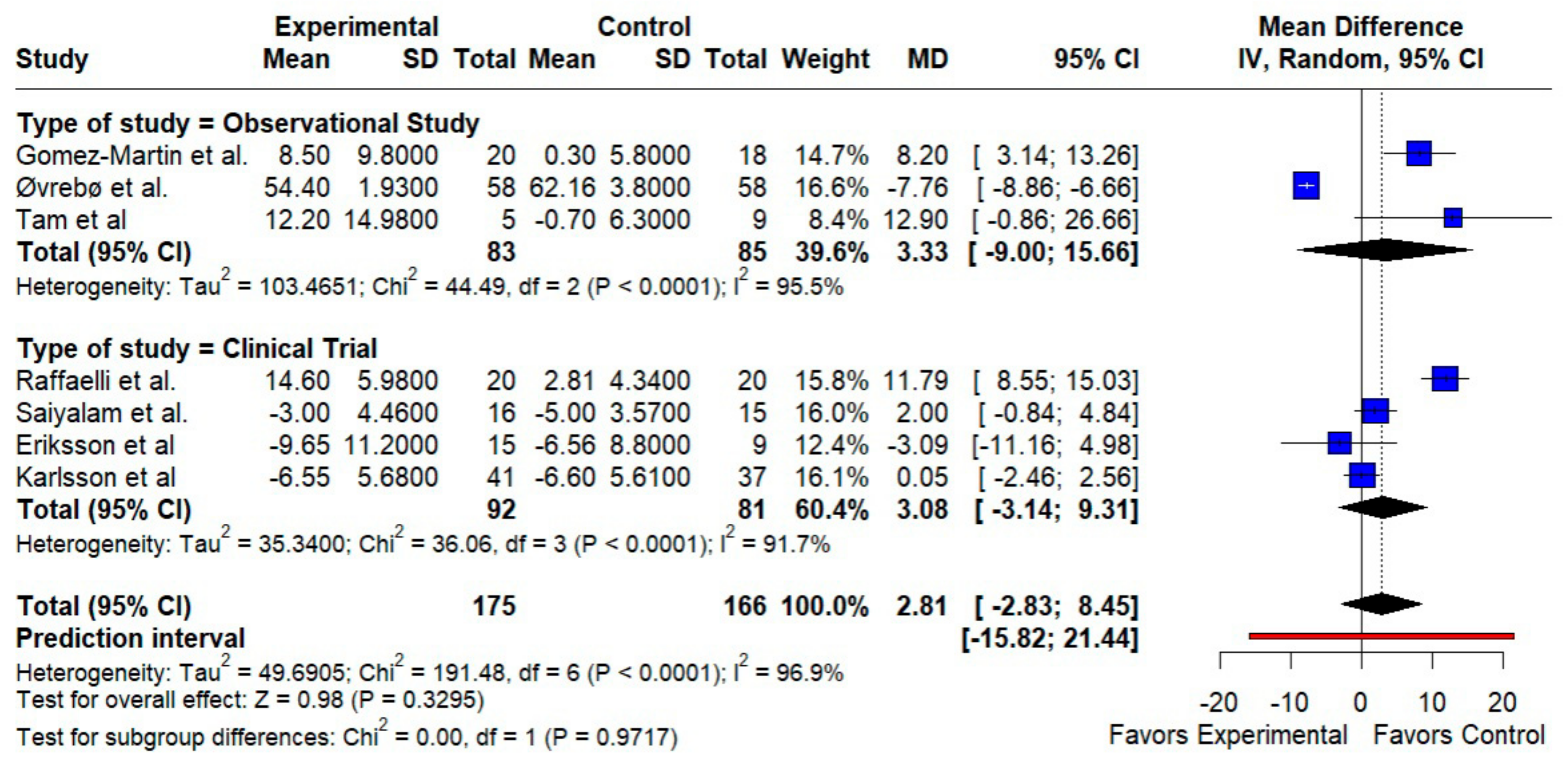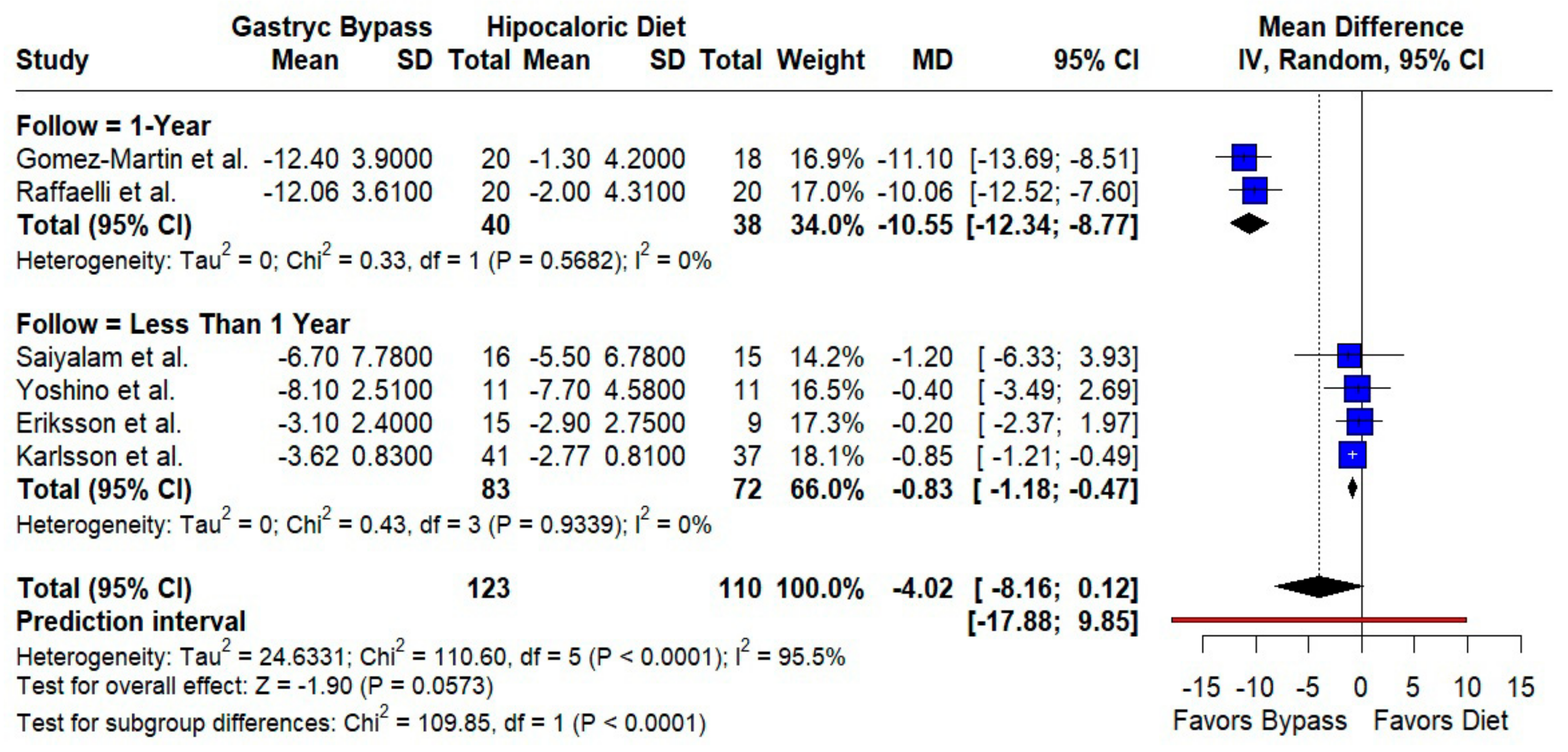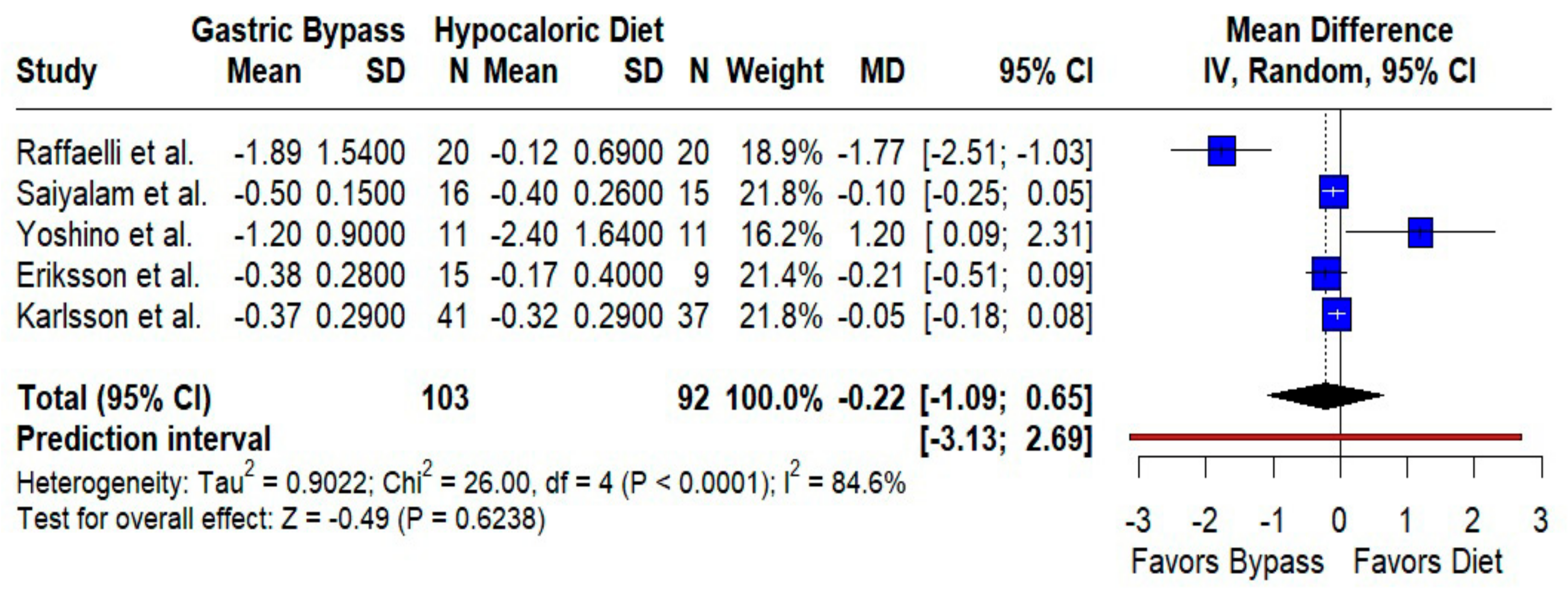Effectiveness of Roux-en-Y Gastric Bypass Versus Hypocaloric Diet in Reducing Cardiovascular Risk Factors in Obese Adults: A Systematic Review and Meta-Analysis
Abstract
1. Introduction
2. Methods
2.1. Study Design
2.2. Information Sources and Search Strategy
2.3. Eligibility Criteria
2.4. Study Selection
2.5. Data Extraction and Items
2.6. Risk of Bias Assessment
2.7. Statistical Analysis
2.8. GRADE Assessment
2.9. Assessment of Small-Study Effects
3. Results
3.1. Study Selection and Characteristics
3.2. Meta-Analytic Findings
3.2.1. Lipid Profile
3.2.2. Body Mass Index
3.2.3. Glycemic Control and Blood Pressure
3.3. Adverse Events
3.4. Risk of Bias
3.5. Certainty of Evidence
3.6. Small-Study Effects/Publication Bias
4. Discussion
5. Conclusions
Supplementary Materials
Author Contributions
Funding
Institutional Review Board Statement
Informed Consent Statement
Data Availability Statement
Conflicts of Interest
Abbreviations
| ApoA1 | Apolipoprotein A1 |
| ApoA4 | Apolipoprotein A4 |
| ApoB | Apolipoprotein B |
| BMI | Body mass index |
| BP | Blood pressure |
| CI | Confidence interval |
| GRADE | Grading of Recommendations, Assessment, Development and Evaluation |
| GRADEpro GDT | GRADEpro Guideline Development Tool |
| HbA1c | Glycated hemoglobin |
| HDL | High-density lipoprotein cholesterol |
| HOMA-IR | Homeostatic Model Assessment of Insulin Resistance |
| I2 | Heterogeneity index |
| IMT | Intima-media thickness |
| kcal/d | Kilocalories per day |
| LCD | Low-calorie diet |
| LDL | Low-density lipoprotein cholesterol |
| Lp(a) | Lipoprotein(a) |
| MD | Mean difference |
| mmHg | Millimeters of mercury |
| NOS | Newcastle–Ottawa Scale |
| non-HDL | Non-high-density lipoprotein cholesterol |
| PET/MRI | Positron Emission Tomography/Magnetic Resonance Imaging |
| PICOT | Population, Intervention, Comparator, Outcomes, Timeframe |
| PRISMA | Preferred Reporting Items for Systematic Reviews and Meta-Analyses |
| PROSPERO | International Prospective Register of Systematic Reviews |
| RCT | Randomized controlled trial |
| RoB 2.0 | Revised Cochrane Risk-of-Bias tool for randomized trials |
| RYGB | Roux-en-Y gastric bypass |
| SBP | Systolic blood pressure |
| SG | Sleeve gastrectomy |
| SoF | Summary of Findings |
| T2D | Type 2 diabetes |
| TG | Triglyceride |
| τ2 | Between-study variance (tau-squared) |
References
- Boutari, C.; Mantzoros, C.S. A 2022 update on the epidemiology of obesity and a call to action: As its twin COVID-19 pandemic appears to be receding, the obesity and dysmetabolism pandemic continues to rage on. Metabolism 2022, 133, 155217. [Google Scholar] [CrossRef] [PubMed]
- Powell-Wiley, T.M.; Poirier, P.; Burke, L.E.; Després, J.-P.; Gordon-Larsen, P.; Lavie, C.J.; Lear, S.A.; Ndumele, C.E.; Neeland, I.J.; Sanders, P.; et al. Obesity and Cardiovascular Disease: A Scientific Statement From the American Heart Association. Circulation 2021, 143, e984–e1010. [Google Scholar] [CrossRef] [PubMed]
- Hofsø, D.; Nordstrand, N.; Johnson, L.K.; Karlsen, T.I.; Hager, H.; Jenssen, T.; Bollerslev, J.; Godang, K.; Sandbu, R.; Røislien, J.; et al. Obesity-related cardiovascular risk factors after weight loss: A clinical trial comparing gastric bypass surgery and intensive lifestyle intervention. Eur. J. Endocrinol. 2010, 163, 735–745. [Google Scholar] [CrossRef]
- Pipek, L.Z.; Moraes, W.A.F.; Nobetani, R.M.; Cortez, V.S.; Condi, A.S.; Taba, J.V.; Nascimento, R.F.V.; Suzuki, M.O.; Nascimento, F.S.D.; de Mattos, V.C.; et al. Surgery is associated with better long-term outcomes than pharmacological treatment for obesity: A systematic review and meta-analysis. Sci. Rep. 2024, 14, 9521. [Google Scholar] [CrossRef]
- Safari, S.; Ekramnia, I.; Chehresonboll, Y.; Ahmadi, V.; Kermansaravi, M. Outcomes and complications after long versus short gastric pouch Roux-en-Y gastric bypass in patients with severe obesity. Sci. Rep. 2024, 14, 31012. [Google Scholar] [CrossRef]
- Gloy, V.L.; Briel, M.; Bhatt, D.L.; Kashyap, S.R.; Schauer, P.R.; Mingrone, G.; Bucher, H.C.; Nordmann, A.J. Bariatric surgery versus non-surgical treatment for obesity: A systematic review and meta-analysis of randomised controlled trials. BMJ 2013, 347, f5934. [Google Scholar] [CrossRef]
- Kim, J.C.; Kim, M.-G.; Park, J.K.; Lee, S.; Kim, J.; Cho, Y.-S.; Kong, S.-H.; Park, D.J.; Lee, H.-J.; Yang, H.-K. Outcomes and Adverse Events After Bariatric Surgery: An Updated Systematic Review and Meta-analysis, 2013–2023. J. Metab. Bariatr. Surg. 2023, 12, 76–88. [Google Scholar] [CrossRef]
- Dastjerdi, P.; Pourfaraji, S.M.; Shayesteh, H.; Maghsoudi, M.; Saeidi, S.; Davani, D.N.; Masouri, M.M.; Roudsari, P.P.; Shirmard, F.O.; Ebrahimi, P.; et al. The role of bariatric surgery in hypertension control: A systematic review and meta-analysis with extended benefits on metabolic factors. BMC Cardiovasc. Disord. 2025, 25, 213. [Google Scholar] [CrossRef]
- Abhishek, F.; Ogunkoya, G.D.; Gugnani, J.S.; Kaur, H.; Muskawad, S.; Singh, M.; Singh, G.; Soni, U.; Julka, D.; Udoyen, A.-O. Comparative Analysis of Bariatric Surgery and Non-surgical Therapies: Impact on Obesity-Related Comorbidities. Cureus 2024, 16, e69653. [Google Scholar] [CrossRef]
- Raffaelli, M.; Guidone, C.; Callari, C.; Iaconelli, A.; Bellantone, R.; Mingrone, G. Effect of Gastric Bypass Versus Diet on Cardiovascular Risk Factors. Ann. Surg. 2014, 259, 694–699. [Google Scholar] [CrossRef]
- Page, M.J.; McKenzie, J.E.; Bossuyt, P.M.; Boutron, I.; Hoffmann, T.C.; Mulrow, C.D.; Shamseer, L.; Tetzlaff, J.M.; Akl, E.A.; Brennan, S.E.; et al. The PRISMA 2020 statement: An updated guideline for reporting systematic reviews. BMJ 2021, 372, n71. [Google Scholar] [CrossRef] [PubMed]
- Nilsen, I.; Andersson, A.; Laurenius, A.; Österberg, J. Low-energy diets before metabolic bariatric surgery: A systematic review of the effect on total body weight, liver volume, glycemia and side effects. Obes. Rev. 2024, 26, e13876. [Google Scholar] [CrossRef] [PubMed]
- Sterne, J.A.C.; Savović, J.; Page, M.J.; Elbers, R.G.; Blencowe, N.S.; Boutron, I.; Cates, C.J.; Cheng, H.Y.; Corbett, M.S.; Eldridge, S.M.; et al. RoB 2: A revised tool for assessing risk of bias in randomised trials. BMJ 2019, 366, l4898. [Google Scholar] [CrossRef] [PubMed]
- Wells, G.A.; Shea, B.; O’Connell, D.; Peterson, J.; Welch, V.; Losos, M.; Tugwell, P. The Newcastle–Ottawa Scale (NOS) for Assessing the Quality of Nonrandomised Studies in Meta-Analyses; Ottawa Hospital Research Institute: Ottawa, ON, USA, 2011; Available online: https://www.ohri.ca/programs/clinical_epidemiology/oxford.asp (accessed on 11 October 2025).
- Guyatt, G.H.; Oxman, A.D.; Vist, G.E.; Kunz, R.; Falck-Ytter, Y.; Alonso-Coello, P.; Schünemann, H.J. GRADE: An emerging consensus on rating quality of evidence and strength of recommendations. BMJ 2008, 336, 924–926. [Google Scholar] [CrossRef]
- Eriksson, J.W.; Pereira, M.J.; Kagios, C.; Kvernby, S.; Lundström, E.; Fanni, G.; Lundqvist, M.H.; Carlsson, B.C.L.; Sundbom, M.; Tarai, S.; et al. Short-term effects of obesity surgery versus low-energy diet on body composition and tissue-specific glucose uptake: A randomised clinical study using whole-body integrated 18F-FDG-PET/MRI. Diabetologia 2024, 67, 1399–1412. [Google Scholar] [CrossRef]
- Karlsson, C.; Johnson, L.K.; Greasley, P.J.; Retterstøl, K.; Hedberg, J.; Hall, M.; Hawker, N.; Robertsen, I.; Havsol, J.; Hertel, J.K.; et al. Gastric Bypass vs. Diet and Cardiovascular Risk Factors: A Nonrandomized Controlled Trial. JAMA Surg. 2024, 159, 971–980. [Google Scholar] [CrossRef]
- Saiyalam, C.; Shantavasinkul, P.C.; Chirnaksorn, S.; Rattanakaemakorn, P.; Taonam, N.; Rodphech, V.; Putadechakum, S.; Rattanasiri, S.; Sirivarasai, J.; Ongphiphadhanakul, B.; et al. Effects of Very Low-Calorie Diet versus Roux-en-Y Gastric Bypass Surgery on Body Composition in Patients with Obesity. Nutrients 2024, 16, 2407. [Google Scholar] [CrossRef]
- Gómez-Martin, J.M.; Aracil, E.; Galindo, J.; Escobar-Morreale, H.F.; Balsa, J.A.; Botella-Carretero, J.I. Improvement in cardiovascular risk in women after bariatric surgery as measured by carotid intima-media thickness: Comparison of sleeve gastrectomy versus gastric bypass. Surg. Obes. Relat. Dis. 2017, 13, 848–854. [Google Scholar] [CrossRef]
- Øvrebø, B.; Strømmen, M.; Kulseng, B.; Martins, C. Bariatric surgery versus lifestyle interventions for severe obesity: 5-year changes in body weight, risk factors and comorbidities. Clin. Obes. 2017, 7, 183–190. [Google Scholar] [CrossRef]
- Tam, C.S.; Redman, L.M.; Greenway, F.; LeBlanc, K.A.; Haussmann, M.G.; Ravussin, E. Energy Metabolic Adaptation and Cardiometabolic Improvements One Year After Gastric Bypass, Sleeve Gastrectomy, and Gastric Band. J. Clin. Endocrinol. Metab. 2016, 101, 3755–3764. [Google Scholar] [CrossRef]
- Yoshino, M.; Kayser, B.D.; Yoshino, J.; Stein, R.I.; Reeds, D.; Eagon, J.C.; Eckhouse, S.R.; Watrous, J.D.; Jain, M.; Knight, R.; et al. Effects of Diet versus Gastric Bypass on Metabolic Function in Diabetes. N. Engl. J. Med. 2020, 383, 721–732. [Google Scholar] [CrossRef] [PubMed]
- Bariatric Surgery More Effective and Durable Than New Obesity Drugs and Lifestyle Intervention. American Society for Metabolic and Bariatric Surgery. 2024. Available online: https://asmbs.org/news_releases/bariatric-surgery-more-effective-and-durable-than-new-obesity-drugs-and-lifestyle-intervention/ (accessed on 18 July 2025).
- Van Veldhuisen, S.L.; Gorter, T.M.; Van Woerden, G.; De Boer, R.A.; Rienstra, M.; Hazebroek, E.J.; Van Veldhuisen, D.J. Bariatric surgery and cardiovascular disease: A systematic review and meta-analysis. Eur. Heart J. 2022, 43, 1955–1969. [Google Scholar] [CrossRef]
- Adams, T.D.; Davidson, L.E.; Litwin, S.E.; Kim, J.; Kolotkin, R.L.; Nanjee, M.N.; Gutierrez, J.M.; Frogley, S.J.; Ibele, A.R.; Brinton, E.A.; et al. Weight and metabolic outcomes 12 years after gastric bypass. N. Engl. J. Med. 2017, 377, 1143–1155. [Google Scholar] [CrossRef]
- Obeid, N.R.; Malick, W.; Concors, S.J.; Fielding, G.A.; Kurian, M.S.; Ren-Fielding, C.J. Long-term outcomes after Roux-en-Y gastric bypass: 10- to 13-year data. Surg. Obes. Relat. Dis. 2016, 12, 11–20. [Google Scholar] [CrossRef]
- Chen, Y.; Corsino, L.M.; Shantavasinkul, P.C.; Grant, J.; Portenier, D.; Ding, L.; Torquati, A.M. Gastric Bypass Surgery Leads to Long-term Remission or Improvement of Type 2 Diabetes and Significant Decrease of Microvascular and Macrovascular Complications. Ann. Surg. 2016, 263, 1138–1142. [Google Scholar] [CrossRef]
- Aminian, A.; Wilson, R.; Zajichek, A.; Tu, C.; Wolski, K.E.; Schauer, P.R.; Kattan, M.W.; Nissen, S.E.; Brethauer, S.A. Cardiovascular Outcomes in Patients With Type 2 Diabetes and Obesity: Comparison of Gastric Bypass, Sleeve Gastrectomy, and Usual Care. Diabetes Care 2021, 44, 2552–2563. [Google Scholar] [CrossRef]
- Kraus, W.E.; Bhapkar, M.; Huffman, K.M.; Pieper, C.F.; Das, S.K.; Redman, L.M.; Villareal, D.T.; Rochon, J.; Roberts, S.B.; Ravussin, E.; et al. 2 years of calorie restriction and cardiometabolic risk (CALERIE): Exploratory outcomes of a multicentre, phase 2, randomised controlled trial. Lancet Diabetes Endocrinol. 2019, 7, 673–683. [Google Scholar] [CrossRef]
- Al Attar, A.A.; Fahed, G.I.; Hoballah, M.M.; Pedersen, S.; El-Yazbi, A.F.; Nasser, S.A.; Bitto, A.; Orekhov, A.N.; Eid, A.H. Mechanisms underlying the effects of caloric restriction on hypertension. Biochem. Pharmacol. 2022, 200, 115035. [Google Scholar] [CrossRef] [PubMed]
- Taegtmeyer, H.; Young, M.E.; Lopaschuk, G.D.; Abel, E.D.; Brunengraber, H.; Darley-Usmar, V.; Rosiers, C.D.; Gerszten, R.; Glatz, J.F.; Griffin, J.L.; et al. Assessing Cardiac Metabolism: A Scientific Statement From the American Heart Association. Circ. Res. 2016, 118, 1659–1701. [Google Scholar] [CrossRef] [PubMed]
- Nicoll, R.; Henein, M.Y. Caloric Restriction and Its Effect on Blood Pressure, Heart Rate Variability and Arterial Stiffness and Dilatation: A Review of the Evidence. Int. J. Mol. Sci. 2018, 19, 751. [Google Scholar] [CrossRef]
- Di Daniele, N.; Marrone, G.; Di Lauro, M.; Di Daniele, F.; Palazzetti, D.; Guerriero, C.; Noce, A. Effects of Caloric Restriction Diet on Arterial Hypertension and Endothelial Dysfunction. Nutrients 2021, 13, 274. [Google Scholar] [CrossRef] [PubMed]
- Lalloyer, F.; Mogilenko, D.A.; Verrijken, A.; Haas, J.T.; Lamazière, A.; Kouach, M.; Descat, A.; Caron, S.; Vallez, E.; Derudas, B.; et al. Roux-en-Y gastric bypass induces hepatic transcriptomic signatures and plasma metabolite changes indicative of improved cholesterol homeostasis. J. Hepatol. 2023, 79, 898–909. [Google Scholar] [CrossRef] [PubMed]
- Osto, E.; Doytcheva, P.; Corteville, C.; Bueter, M.; Dörig, C.; Stivala, S.; Buhmann, H.; Colin, S.; Rohrer, L.; Hasballa, R.; et al. Rapid and body weight–independent improvement of endothelial and high-density lipoprotein function after Roux-en-Y gastric bypass: Role of glucagon-like peptide-1. Circulatiron 2015, 131, 871–881. [Google Scholar] [CrossRef]
- Rossi, I.; Omotosho, P.; Poirier, J.; Spagnoli, A.; Torquati, A. Roux-en-Y gastric bypass decreases serum inflammatory markers and cardiovascular risk factors in obese diabetics. Surgery 2021, 169, 539–542. [Google Scholar] [CrossRef]
- Vincent, R.P.; le Roux, C.W. The satiety hormone peptide YY as a regulator of appetite. J. Clin. Pathol. 2008, 61, 548–552. [Google Scholar] [CrossRef]
- Meiselman, H.L. (Ed.) Handbook of Eating and Drinking: Interdisciplinary Perspectives; Springer International Publishing: Cham, Switzerland, 2020. [Google Scholar] [CrossRef]
- Penney, N.C.; Kinross, J.; Newton, R.C.; Purkayastha, S. The role of bile acids in reducing the metabolic complications of obesity after bariatric surgery: A systematic review. Int. J. Obes. 2015, 39, 1565–1574. [Google Scholar] [CrossRef]
- Liu, H.; Hu, C.; Zhang, X.; Jia, W. Role of gut microbiota, bile acids and their cross-talk in the effects of bariatric surgery on obesity and type 2 diabetes. J. Diabetes Investig. 2018, 9, 13–20. [Google Scholar] [CrossRef]
- Artinian, N.T.; Fletcher, G.F.; Mozaffarian, D.; Kris-Etherton, P.; Van Horn, L.; Lichtenstein, A.H.; Kumanyika, S.; Kraus, W.E.; Fleg, J.L.; Redeker, N.S.; et al. Interventions to promote physical activity and dietary lifestyle changes for cardiovascular risk factor reduction in adults: A scientific statement from the American Heart Association. Circulation 2010, 122, 406–441. [Google Scholar] [CrossRef]
- Saha, S.P.; Banks, M.A.; Whayne, T.F. Managing Cardiovascular Risk Factors without Medications: What is the Evidence? Cardiovasc. Hematol. Agents Med. Chem. 2021, 19, 8–16. [Google Scholar] [CrossRef]
- Sisti, L.; Dajko, M.; Campanella, P.; Shkurti, E.; Ricciardi, W.; de Waure, C. The effect of multifactorial lifestyle interventions on cardiovascular risk factors: A systematic review and meta-analysis of trials conducted in the general population and high risk groups. Prev. Med. 2018, 109, 82–97. [Google Scholar] [CrossRef]
- Wing, R.R.; Lang, W.; Wadden, T.A.; Safford, M.; Knowler, W.C.; Bertoni, A.G.; Hill, J.O.; Brancati, F.L.; Peters, A.; Wagenknecht, L.; et al. Benefits of modest weight loss in improving cardiovascular risk factors in overweight and obese individuals with type 2 diabetes. Diabetes Care 2011, 34, 1481–1486. [Google Scholar] [CrossRef] [PubMed]
- Calder, P.C. Feeding the immune system. Proc. Nutr. Soc. 2013, 72, 299–309. [Google Scholar] [CrossRef] [PubMed]
- Lincoff, A.M.; Brown-Frandsen, K.; Colhoun, H.M.; Deanfield, J.; Emerson, S.S.; Esbjerg, S.; Hardt-Lindberg, S.; Hovingh, G.K.; Kahn, S.E.; Kushner, R.F.; et al. Semaglutide and Cardiovascular Outcomes in Obesity without Diabetes. N. Engl. J. Med. 2023, 389, 2221–2232. [Google Scholar] [CrossRef] [PubMed]
- Jastreboff, A.M.; Aronne, L.J.; Ahmad, N.N.; Wharton, S.; Connery, L.; Alves, B.; Kiyosue, A.; Zhang, S.; Liu, B.; Bunck, M.C.; et al. Tirzepatide once weekly for the treatment of obesity. N. Engl. J. Med. 2022, 387, 205–216. [Google Scholar] [CrossRef]
- Fatoye, F.; Mbada, C.; Niyi-Odumosu, F.; Fatoye, C.; Useh, U.; Hakimi, Z.; Gebrye, T. The clinical and economic burden of obesity in low- and middle-income countries: A systematic review. Int. J. Obes. 2025, 49, 2453–2461. [Google Scholar] [CrossRef]
- Floyd, N.A.; Dominguez-Cancino, K.A.; Butler, L.G.; Rivera-Lozada, O.; Leyva-Moral, J.M.; Palmieri, P.A. The effectiveness of care bundles including the braden scale for preventing hospital acquired pressure ulcers in older adults hospitalized in ICUs: A systematic review. Open Nurs. J. 2021, 15, 74–84. [Google Scholar] [CrossRef]
- Lozada-Urbano, M.; Huamán, F.; Xirinachs, Y.; Rivera-Lozada, O.; Alvarez-Risco, A.; Yáñez, J.A. Poverty, Household Structure and Consumption of Foods Away from Home in Peru in 2019: A Cross-Sectional Study. Foods 2022, 11, 2547. [Google Scholar] [CrossRef]
- Namaziandost, E.; Hashemifardnia, A.; Bilyalova, A.A.; Fuster-Guillén, D.; Garay, J.P.P.; Diep, L.T.N.; Ismail, H.; Sundeeva, L.A.; Hibana; Rivera-Lozada, O. The Effect of WeChat-Based Online Instruction on EFL Learners’ Vocabulary Knowledge. Educ. Res. Int. 2021, 2021, 20218825450. [Google Scholar] [CrossRef]







| Author (Year) | Journal | Journal Ranking | Study Design | No. of Patients | Location; Period | Population | Intervention Type | Comparison | Main Outcomes |
|---|---|---|---|---|---|---|---|---|---|
| Eriksson et al. (2024) [16] | Diabetologia | Endocrinology and Metabolism, Q1 | Randomized Clinical Trial | Surgery: 15; LCD: 9 | Sweden; ~2022–2023 | Obese adults without diabetes | Surgery vs. diet | SG/RYGB vs. Hypocaloric Diet (~1100 kcal/d, 4 weeks) | Glucose uptake (PET/MRI), HOMA-IR, lipids |
| Karlsson et al. (2024) [17] | JAMA Surgery | Surgery, Q1 | Non-randomized Clinical Trial | RYGB: 41; VLED: 37 | Norway; 2015–2017 | Severe obesity, adults | Surgery vs. diet | RYGB vs. Hypocaloric Diet (<800 kcal/d, 6 weeks) | LDL, non-HDL, ApoB, Lp(a), glucose, BP |
| Saiyalam et al. (2024) [18] | Nutrients | Nutrition and Dietetics, Q1 | Non-randomized Clinical Trial | SG: 89; RYGB: 89 | Turkey; ~2021–2023 | Obese with T2D | Surgical (SG vs. RYGB) | Surgical Hypocaloric Diet | HDL, LDL, TG, glucose, HbA1c |
| Raffaelli et al. (2014) [10] | Annals of Surgery | Surgery, Q1 | Non-randomized Clinical Trial | RYGB: 40; Control: 40 | Italy; ~2010–2012 | Obese with metabolic syndrome | Surgery vs. diet/behavioral | RYGB vs. Hypocaloric Diet and Behavior Therapy | HDL, ApoA4, TG, HOMA-IR |
| Gómez-Martín et al. (2017) [19] | Surgery for Obesity and Related Diseases | Surgery, Q1 | Observational Study | RYGB: 20; Control: 18 | Spain; ~2015–2016 | Obese females only | Surgery vs. control | Surgical vs. Hypocaloric Diet | IMT, endothelial dysfunction markers |
| Øvrebø B. et al. (2017) [20] | Clinical Obesity | Endocrinology, Diabetes, and Metabolism, Q2 | Observational Study | SG: 67; RYGB: 67 | Norway; ~2013–2015 | Patients with morbid obesity | Surgical (SG vs. RYGB) | Surgical vs. Hypocaloric Diet | HDL, LDL, TG, ApoA1, ApoB, glucose, HbA1c |
| Tam et al. (2016) [21] | Journal of Clinical Endocrinology and Metabolism | Endocrinology and Metabolism, Q1 | Observational Study | SG: 33; RYGB: 33 | Hong Kong; ~2013–2015 | Obese patients (BMI ≥ 35) | Surgical (SG vs. RYGB) | Surgical vs. Hypocaloric Diet | HDL, LDL, HOMA-IR, TG, glucose |
| Yoshino et al. (2020) [22] | New England Journal of Medicine | Medicine (miscellaneous), Q1 | Observational Study | RYGB: 11; Diet: 11 | USA; ~2019–2020 | Obese patients | Surgery vs. diet | RYGB vs. Hypocaloric Diet 1000 kcal/d) | HDL, LDL, TG, glucose, HbA1c |
Disclaimer/Publisher’s Note: The statements, opinions and data contained in all publications are solely those of the individual author(s) and contributor(s) and not of MDPI and/or the editor(s). MDPI and/or the editor(s) disclaim responsibility for any injury to people or property resulting from any ideas, methods, instructions or products referred to in the content. |
© 2025 by the authors. Licensee MDPI, Basel, Switzerland. This article is an open access article distributed under the terms and conditions of the Creative Commons Attribution (CC BY) license (https://creativecommons.org/licenses/by/4.0/).
Share and Cite
López-Delgado, D.S.; Narvaez, C.A.; Calzada Gonzales, N.D.; Martinez-Galaviz, R.; Rivera-Lozada, O.; Barboza, J.J. Effectiveness of Roux-en-Y Gastric Bypass Versus Hypocaloric Diet in Reducing Cardiovascular Risk Factors in Obese Adults: A Systematic Review and Meta-Analysis. J. Clin. Med. 2025, 14, 8349. https://doi.org/10.3390/jcm14238349
López-Delgado DS, Narvaez CA, Calzada Gonzales ND, Martinez-Galaviz R, Rivera-Lozada O, Barboza JJ. Effectiveness of Roux-en-Y Gastric Bypass Versus Hypocaloric Diet in Reducing Cardiovascular Risk Factors in Obese Adults: A Systematic Review and Meta-Analysis. Journal of Clinical Medicine. 2025; 14(23):8349. https://doi.org/10.3390/jcm14238349
Chicago/Turabian StyleLópez-Delgado, Darío S., Carlos A. Narvaez, Nancy Doris Calzada Gonzales, Rodrigo Martinez-Galaviz, Oriana Rivera-Lozada, and Joshuan J. Barboza. 2025. "Effectiveness of Roux-en-Y Gastric Bypass Versus Hypocaloric Diet in Reducing Cardiovascular Risk Factors in Obese Adults: A Systematic Review and Meta-Analysis" Journal of Clinical Medicine 14, no. 23: 8349. https://doi.org/10.3390/jcm14238349
APA StyleLópez-Delgado, D. S., Narvaez, C. A., Calzada Gonzales, N. D., Martinez-Galaviz, R., Rivera-Lozada, O., & Barboza, J. J. (2025). Effectiveness of Roux-en-Y Gastric Bypass Versus Hypocaloric Diet in Reducing Cardiovascular Risk Factors in Obese Adults: A Systematic Review and Meta-Analysis. Journal of Clinical Medicine, 14(23), 8349. https://doi.org/10.3390/jcm14238349








